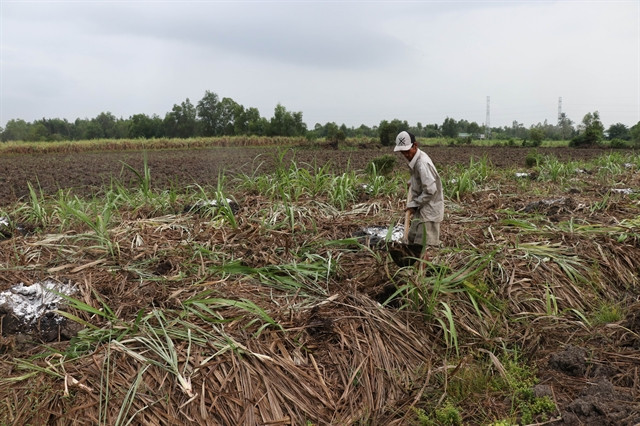 Farmer Huynh Van Ut in Long An province’s Ben Luc district has switched from sugarcane to other crops (Photo: VNA)
Farmer Huynh Van Ut in Long An province’s Ben Luc district has switched from sugarcane to other crops (Photo: VNA)HCMCity (VNS/VNA) - The area under sugarcane in the Mekong Delta hasshrunk dramatically during the 2019-20 crop after many farmers switched toother crops following losses in recent years.
In Long An province, it has fallen to 3,800ha from 12,000ha in peakyears.
Ben Luc district, which has the largest area under the crop in Long An, isplanting 3,000ha.
Nguyen Hue, who has planted sugarcane for many years in its Luong Hoa commune,said he has reduced his sugarcane growing area to 6ha after making losses inrecent years.
He is growing the sugarcane this time from old roots since he does not want tospend more on new seedlings, he said.
“I did not want to give up sugarcane because it has made my family well-off.But I cannot sell sugarcane.”
He is growing coconut trees on the rest of the area where he was previouslygrowing sugarcane, he added.
Farmers earned 5-7 million VND (215-300 USD) from a hectare of sugarcane duringthe last crop after spending 10 million VND (430 USD) on fertiliser alone.
In Tra Cu District, the largest sugarcane farming area in Tra Vinh province,the crop is grown only on 2,540ha, down by 50 percent from previous years,according to the local Agriculture and Rural Development Bureau.
Huynh Van Thao, head of the bureau, said farmers suffered heavy losses aftersugarcane prices fell for two consecutive years.
Kien Phume, a farmer in Tra Cu district’s Ngai Xuyen commune who has switchedto other crops this time, said after the last crop the Tra Vinh Sugarcane OneMember Limited Company bought sugarcane with a commercial cane sugar (CCS)sweetness level of 10 at a price of 850 VND per kilogramme, down nearly 100 VNDfrom the previous season.
Farmers suffer losses at this price, she said.
She has stopped growing sugarcane on her 6,000sq.m field this year and insteadgrows vegetables on 2,000sq.m and rice on 4,000sq.m, she said.
Sheearns around 250,000 VND (11 USD) a day from selling mustard leaves, greenonions and herbs.
But many other sugarcane farmers in the district lack the money and farmingknowledge to switch to other crops.
The bureau has instructed some farmers in growing other crops and they havebegun to grow other crops on 530ha.
Support policies
The TraVinh Sugarcane One Member Limited Company has announced a further 100 VND cutper kilogramme in sugarcane buying prices in the 2019-20 crop to 700 VND.
However, it is helping farmers in other ways like advancing money at lowinterest rates to buy sugarcane seedlings and fertiliser, offering themtraining in farming techniques, and reducing middlemen.
Cao Van Tong, director of the Luu Nghiep Agricultural Co-operative in Tra CuDistrict, said despite the lower sugarcane prices, farmers are benefiting fromthe company’s policies.
Co-operatives, co-operative teams and households that have at least one hectareof sugarcane and sign a contract with the company are offered assistance andguaranteed outlets.
Tran Ngoc Hieu, general director of Tra Vinh Sugarcane, said the company alsogives 2 million VND (860 USD) per hectare to farmers who switch from othercrops to sugarcane and pledge to grow at least two crops.
The company then instructs them in farming techniques, growing processes andtreating pests and diseases, he added.
In HauGiang province, which has the largest area under sugarcane in the delta, the CanTho Sugar Joint Stock Company (Casuco) buys much of the local output.
Pham Quang Vinh, deputy general director of Casuco, said the company woulddirectly buy sugarcane from farmers in the 2019-20 season and not throughtraders like in the past.
Casuco buys sugarcane grown on around 6,000ha, he said.
It recently decided to suspend operations at one of its two sugar mills in theprovince until the next sugarcane crop.
It is implementing policies to assist farmers, hoping to increase thecontracted area under sugarcane in the province to 10,000-15,000ha.
But Hau Giang province only has 8,300ha under the crop this year, according toits Department of Agriculture and Rural Development.
The delta has 10 sugar mills but four of them have suspended operations due toseveral reasons, including losses and a decline in sugarcane farming areas.- VNS/VNA





























